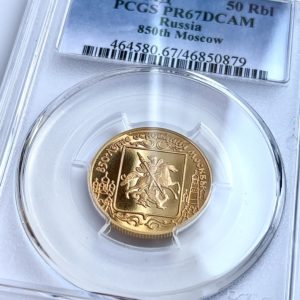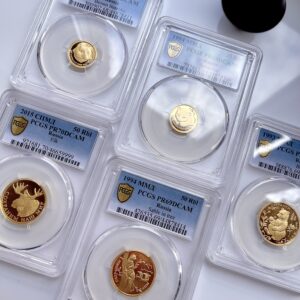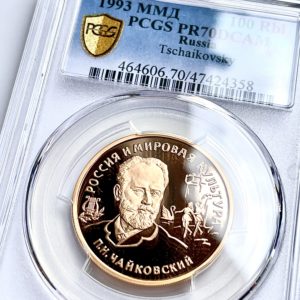Saint George, who slew the dragon, can be found on the coins of many countries. This blog is specifically about Russian bullion coins. Before we begin, let’s look at the difference between collectible coins and bullion coins.
Collector coins made of precious metals are minted in small editions and in most cases have “proof” (PP – polished plate) quality (high gloss and matte relief).
Bullion coins are minted in regular quality and in much larger quantities.
More: https://rarecoinv4.wpengine.com/blog/differences-between-collectors-and-investment-coins/
Who was Saint George?
Saint George is the patron saint of Moscow and is venerated in various countries. Since 1781 it has been depicted on the coat of arms of the Russian capital. The face of the saint adorns collector coins, and the icon is used to bless the defenders of the Fatherland.
Who was and how did St. George the Victorious live
St. George was the son of the rich military leader Gerontius. His father died on the battlefield when George was still a teenager, and his mother sent him to the army. The brave and steadfast young warrior was soon appointed general by Emperor Diocletian.
When Georg was 20 years old, he became an orphan and received a good inheritance. By this time Diocletian had already announced the persecution of Christians. George got to know the followers of Christ and became a believer himself. He decided to give his inheritance to the poor and then confessed his faith before the emperor. Diocletian first tried to persuade George to renounce Christ, at least formally, but received a stern refusal. He then ordered Georg to be tortured. For nine days George was tortured and many people witnessed miracles. These people believed in Christ, but Emperor Diocletian remained adamant. Eventually, George was executed.
The belief is that the saint was buried in a church in the city of Lod and the severed head and sword were kept in Rome. In 1821, several heads were mentioned to be kept in Venice, Prague, Constantinople and other cities. Each of these heads was mistaken for the head of St. George the Victorious. Some of the relics are kept in the Sainte-Chapelle in Paris. The other part of the relics, the right hand, is located on the holy Mount Athos.
The heroic deed of the saint George
The most famous feat attributed to St. George is the slaying of the dragon.
The legend says that in a small town near Palestine lived a huge dragon, which everyone was afraid of. In order not to anger the dragon, the villagers fed him a young girl every month. In time, however, there was not a single girl left in the city, and the ruler was forced to sacrifice his own daughter. George happened to be nearby when the girl hid crying on the outskirts of town. She told him that she was preparing to die. When the mighty dragon appeared, brave Georges fought it and defeated it: he stabbed the monster to the ground with his spear and his horse kicked it to death. All the inhabitants of the town were infinitely grateful to George.
In memory of St. George
Saint George has been venerated since early Christianity. The first temples to the martyr were built in the Roman Empire in the fourth century. The cult of St. George replaced the cult of Dionysus. Cathedrals in honor of the great martyr of Orthodoxy were built in various places.
Saint George became an example of bravery and courage. The martyr was venerated especially in Georgia. The first temple built in memory of the martyr is dated 335. Over time, the number of churches and shrines grew. There are 365 sacred buildings in Georgia, as many as there are days in a year. There is not a single cathedral in the country that is not home to an icon of St. George.
In Georgia, it is popular to name a boy Georgy. It is believed that the bearer of such a name is accompanied by good luck and victory. From ancient Russian times Georgy is known as Yuri and Egoriy.
In 1769, Empress Catherine II approved the Order of St. George the Victorious. The award was given for merits in battle and military service. In 1917, the new Soviet rulers abolished the Order. In the noughties, the Order was reinstated as a military award of the Russian Federation. The Order of St. George is decorated with a two-color St. George ribbon. And the St. George ribbon serves as a symbol of the celebration of the Victory Day.
Saint-George band
The Saint George ribbon (Russian георгиевская ленточка or transcribed georgiyevskaya lentochka), also called George ribbon or George ribbon, is a Russian military insignia consisting of a pattern of three black and two orange stripes. It goes back to a military award given in the Russian Empire and later reintroduced in the Soviet Union under a different name.
Gold bullion coin and silver bullion coins
Saint George gold bullion coin contains 7.78 g of pure gold (0.999) and was minted in the Moscow Mint. First published in 2006. The obverse shows the emblem of Russia, a double-headed eagle with outstretched wings. On the back there is a relief of St. George on his horse slaying the snake with his spear. This series includes the gold bullion coin “Saint George” minted by the St. Petersburg Mint and the gold bullion coin “Saint George” in blister 2014 minted by the Moscow Mint and the St. Petersburg Mint.
Silver bullion coin Saint George – pure silver (0, 999 proof) – 31, 1 g. The obverse shows the emblem of the Bank of Russia – a double-headed eagle with outstretched wings. The reverse shows St. George slaying the serpent with his spear.
50 rubles “Saint George
As the Bank of Russia points out in its 2006 catalog, the issue of the gold bullion coin “Saint George” summarizes the results of the “Chervonets” sales era of 1975-1982. Most credit institutions that sold “chervonets” were worried because investors were in no hurry to return these coins to the banks. Therefore, the resulting niche urgently needed to be filled with something. At that time, most modern foreign bullion coins were made of pure gold (999 or higher). LMD (LMD = SPMD, St. Petersburg Mint) has mastered the minting of the highest quality gold coins since 1991.
Appearance of coins from Moscow and St. Petersburg
The Bank of Russia makes no distinction between the MMD and SPMD coins and has given them the same catalog number. Regardless of the date on the obverse, the coins of different vintages have the same number. Owners of the “Pobedonosets” coins/Holy George coins can easily distinguish between the Moscow and St. Petersburg coins: The MMD has a matte field as well as relief elements, while the SPMD has a shiny relief compared to the matte field.
Mintage number of gold coins
Since Saint George are bought not only by investors, but also by collectors, here you will find the mintage figures of these coins. The values are taken from the catalogs of the Bank of Russia and may contradict the data once specified in the plans of the Central Bank. For example, the 2015 print run, previously set at hundreds of thousands of copies, was reduced to 30,000. And the 2016 coin with a mintage of up to 500,000 was suddenly dropped from the plan altogether. Proof coins are not listed.
Changes to the “Saint George” coins from 2021
Outside Russia, the main unit of weight for bullion coins is an ounce. Ounces of gold bullion coins are in high demand among consumers and are produced by mints around the world. Therefore, Saint George bullion coins will be available in 1 oz, 1/2 oz, 1/4 oz and 1/10 oz pure gold denominations starting in 2021. The new weight versions are available for purchase in editions of 100,000 each. Until then, Russia had not yet issued gold coins of one ounce. This is due to the fact that Russian private investors simply cannot afford to buy such capital goods. The price of an ounce of gold is a multiple of the real average income of citizens.
The capsule of gold coins
It is important to know in which capsule St. George left the mint. Although these coins are bullion coins whose value is determined by their metal value, some dealers will lower the purchase price if the coin is not offered in its original capsule or without a capsule at all.
Surely also interesting for you:
https://rarecoinv4.wpengine.com/goldmuenzen-aus-russland/
https://rarecoinv4.wpengine.com/blog/russische-goldmuenzen-praegestaette/
Discover our gold coin collection from Russia in the current range!
-

50 rubles 1997 – 850 years of Moscow – PCGS PR69 DCAM
950,00 €plus shippingDelivery Time: approx. 2-3 days (excluding Saturdays, Sundays and public holidays)







